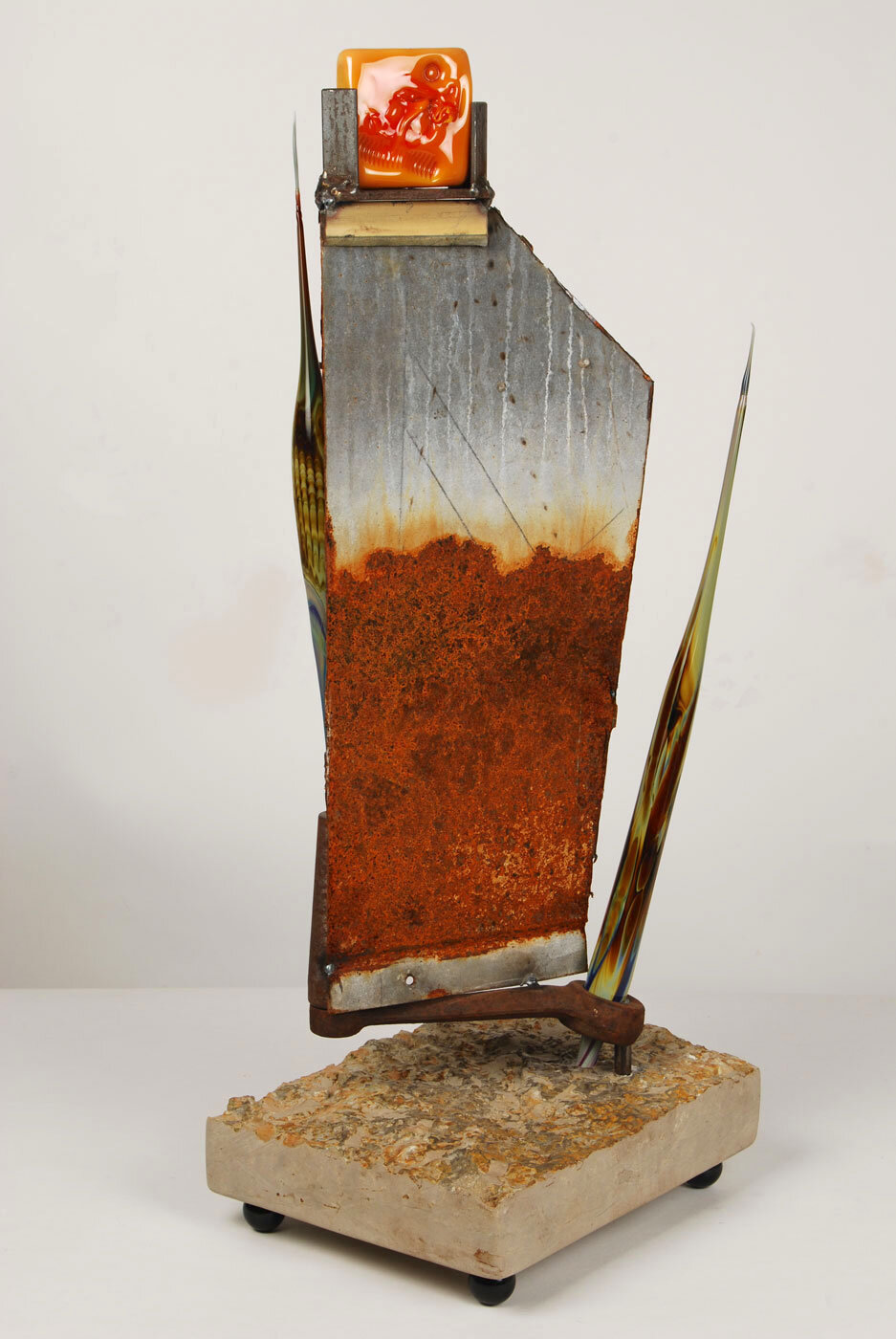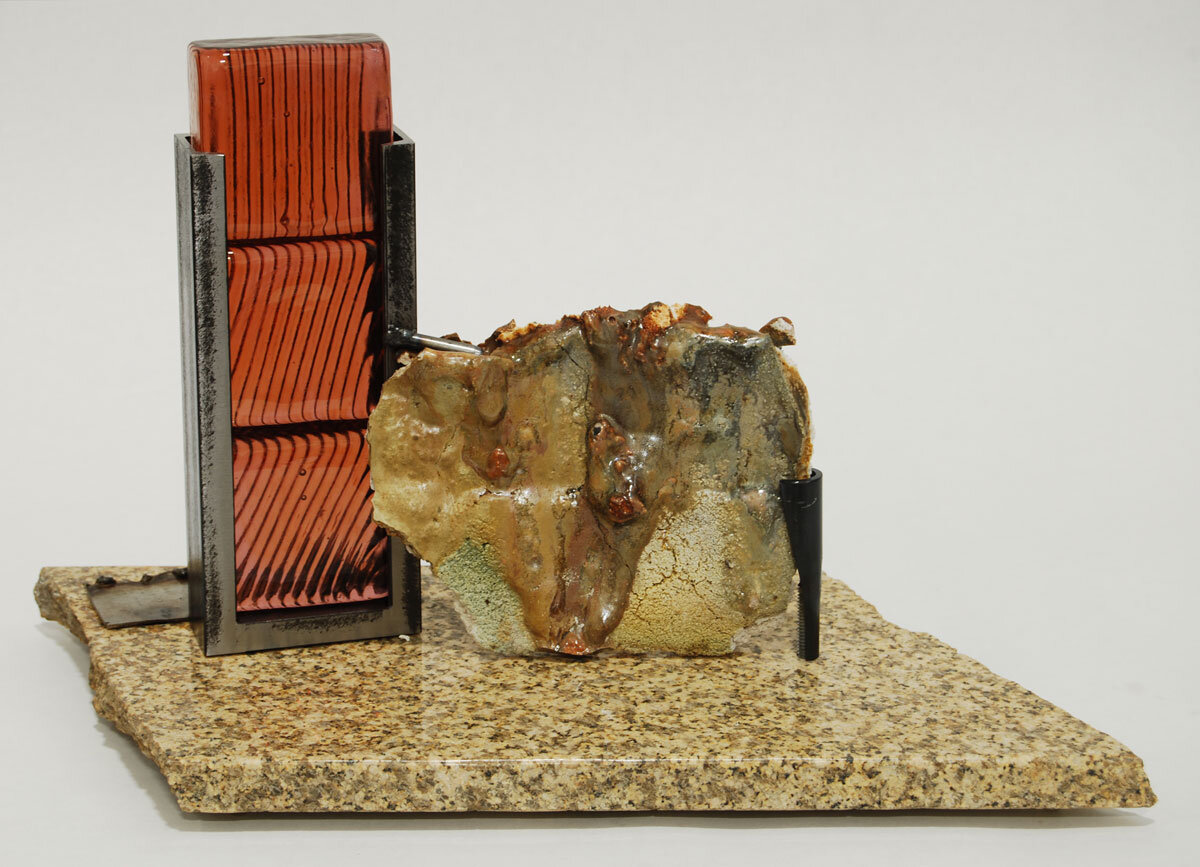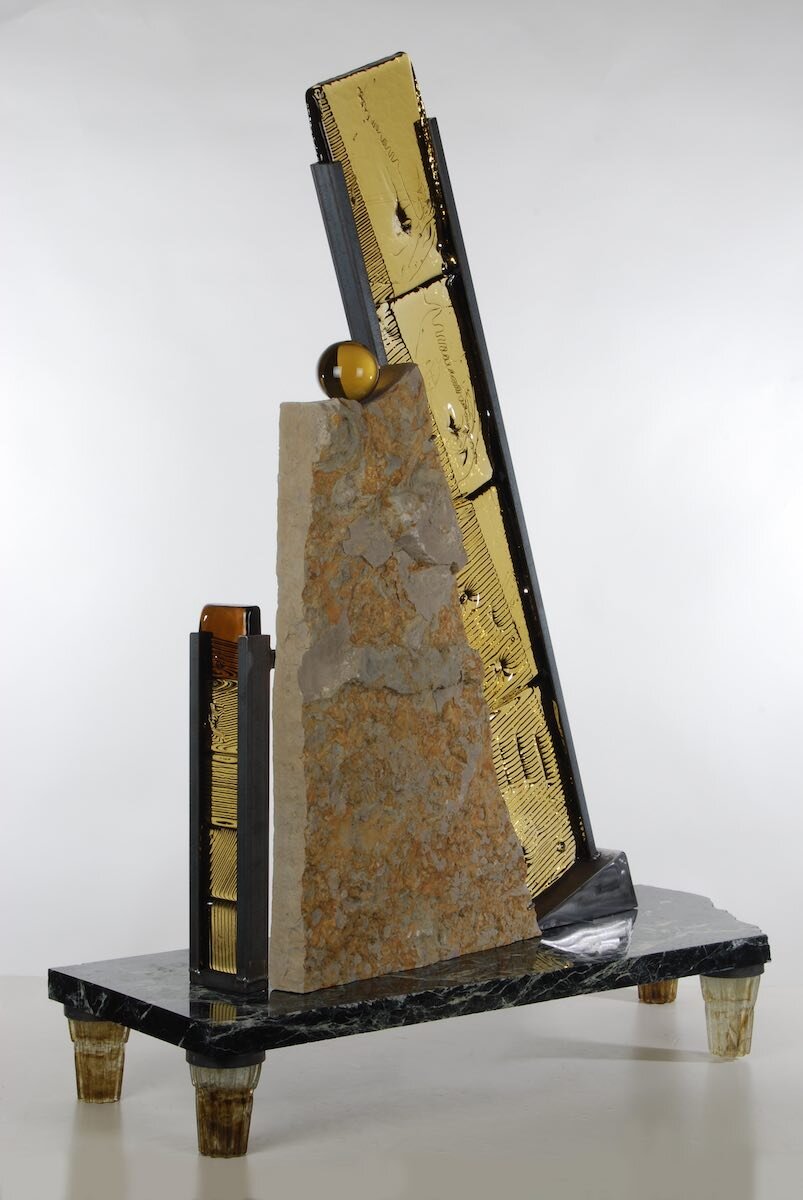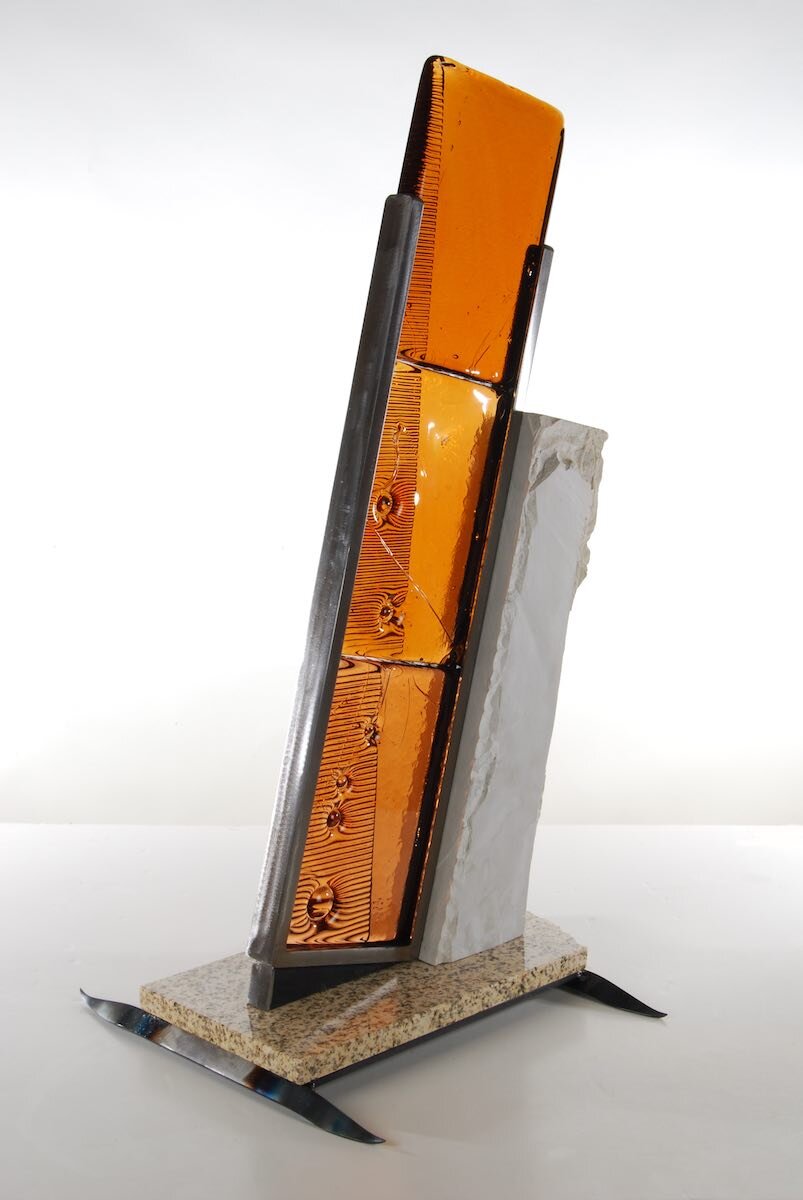Interview with artist Ed Pennebaker
Ed Pennebaker is a versatile glass artist who was originally trained in printmaking. After earning a B.F.A. and M.A. with emphasis in printmaking from Emporia State University in Kansas, where he was born. He was introduced to working with hot glass as an Artist-in-the-Schools resident artist in Liberal, Kansas from 1981-1983. He honed his skills blowing glass at Hale Farm and Village in Bath, Ohio. Producing glass functional forms eventually led to working with sculptural lighting and then to pure sculpture. Ed’s work has been sought after for collections all over the world and has been exhibited in museums and galleries in the US and abroad.
Ed moved to Salem, Arkansas in 1985 and established the Red Fern Glass Studio. In 2018, Ed and his wife Carol Corning, a mixed-media artist, moved the studio to Clinton, Arkansas. Ed now uses a variety of media to create works that address his concerns for the environment.
Ed’s chandeliers and mixed-media sculptures can be found at Red Fern Glass, artglass-sculpture.com, Zarks Gallery in Eureka Springs, AR, The Taylor Gallery in Springdale, AR, and Library Square in Little Rock, AR.
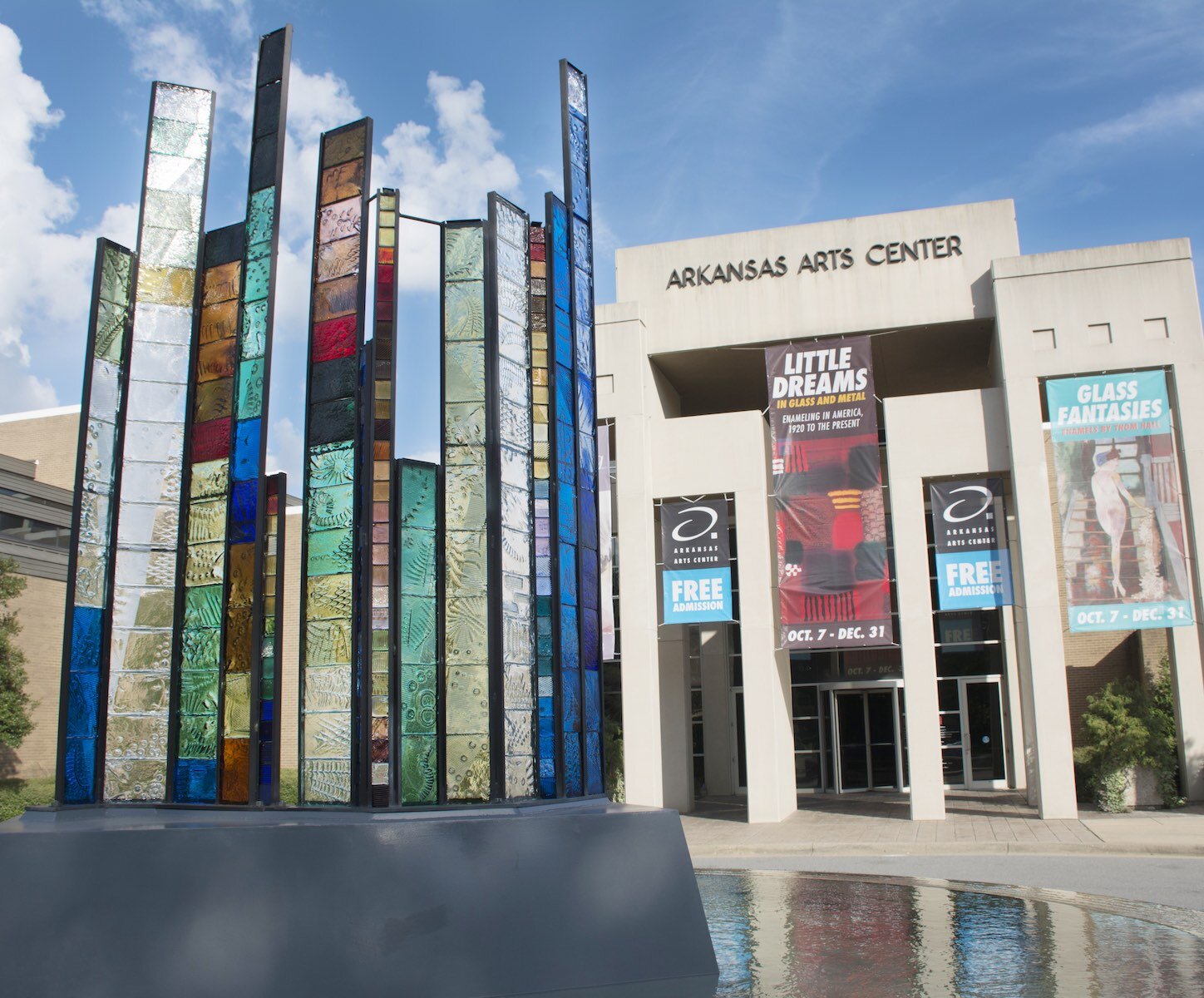
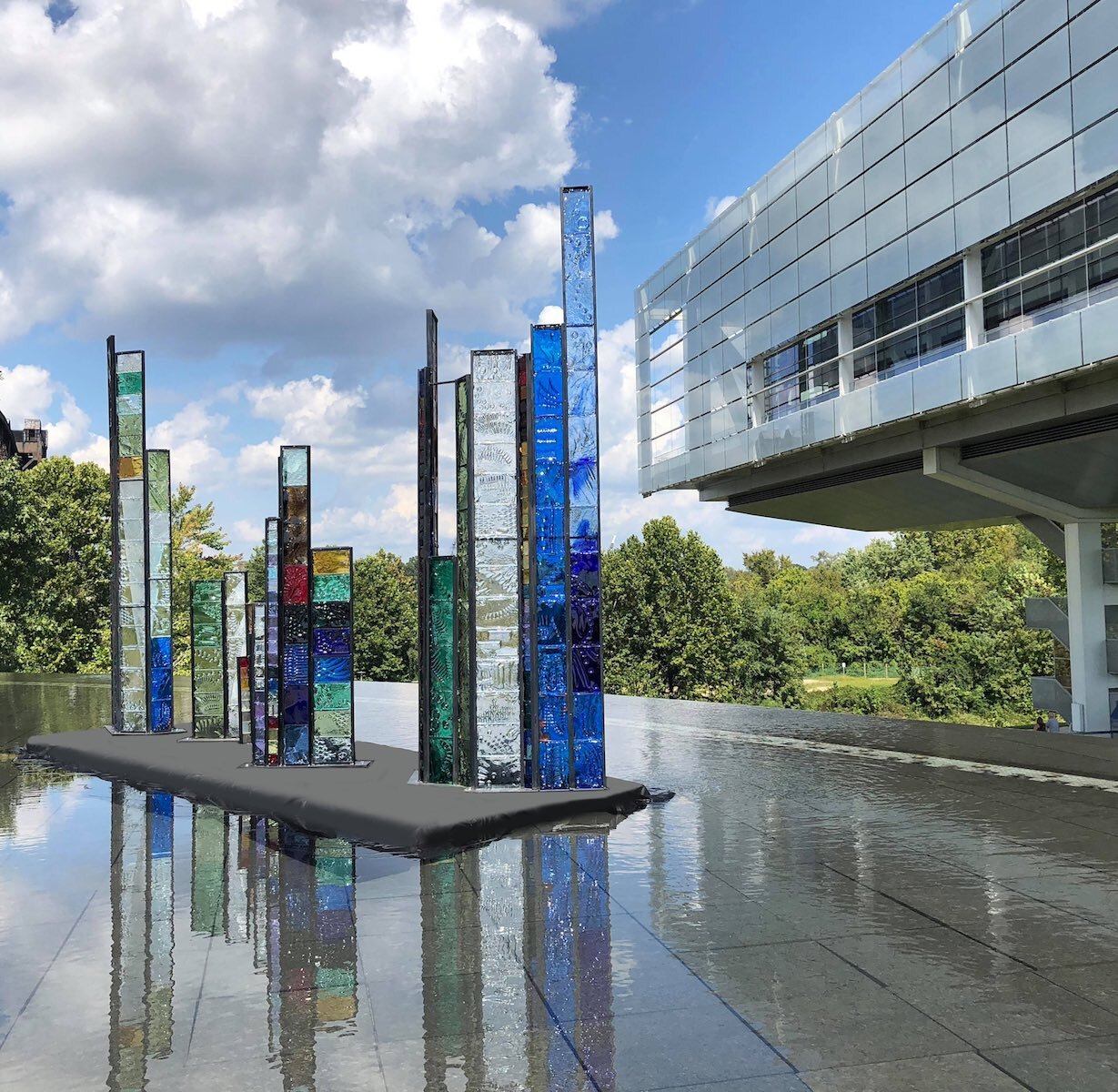
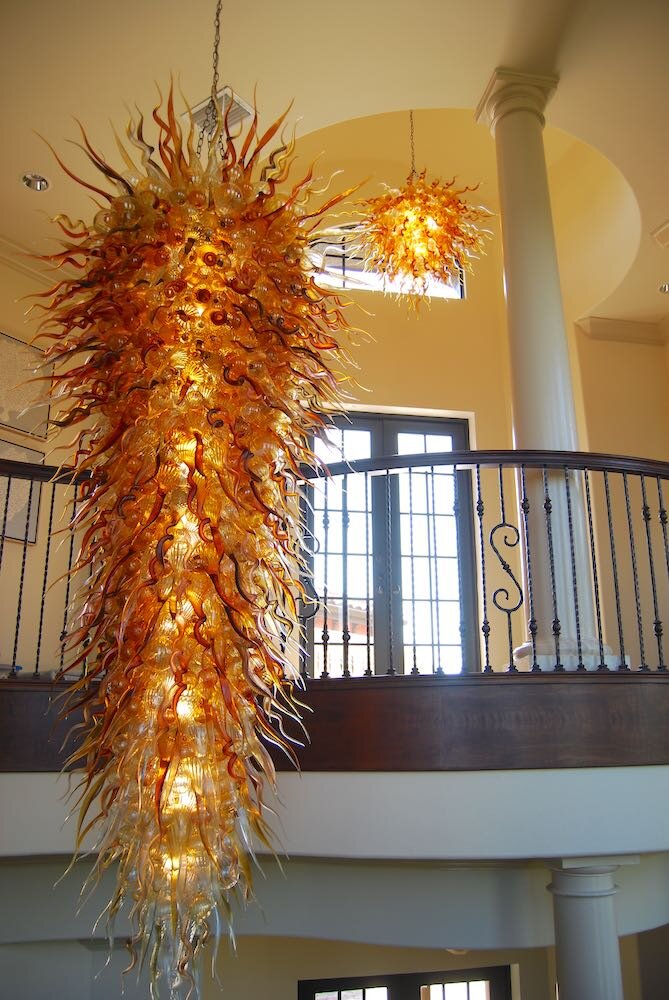
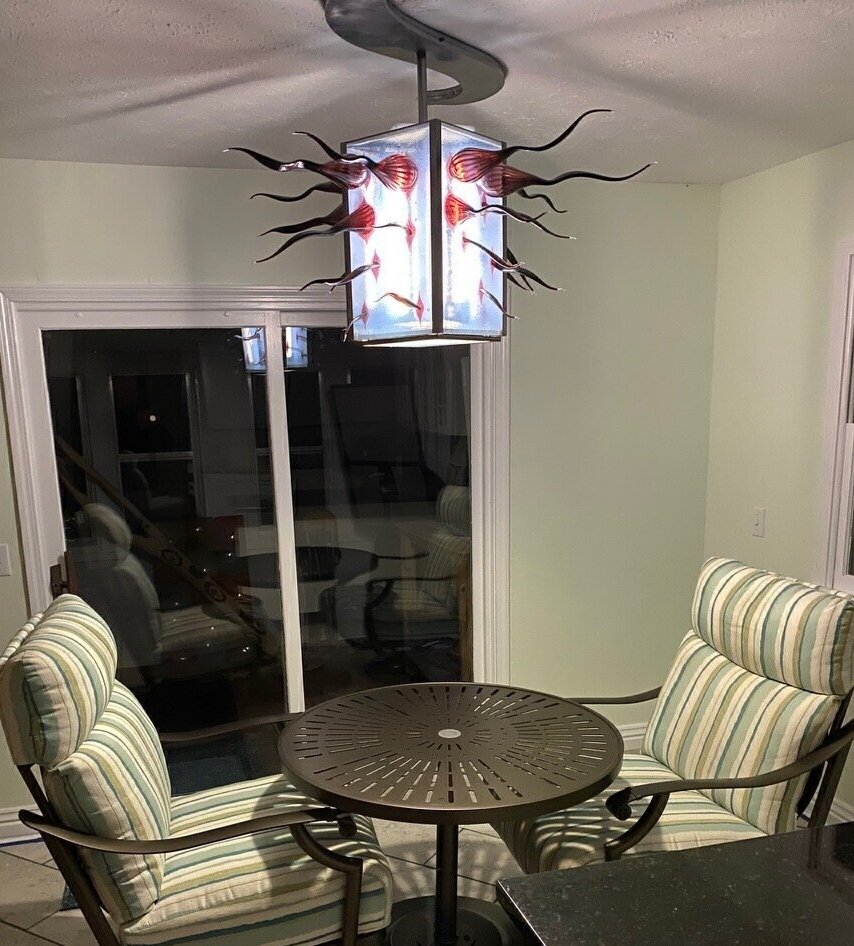
AAS: Tell me about your background. Are you originally from Arkansas?
EP: My mother’s side of the family is from Arkansas, so we visited here a lot. I was born and raised in Kansas. After two years at Garden City Community College, I earned a B.F.A. and M.A. in art at Emporia State University with an emphasis in printmaking. I concentrated on screen printing although I worked in all the printmaking media. Emporia State has a glass program and I was interested in it but after transferring from community college, I didn’t have the prerequisites to get into the degree program.
AAS: I saw my first blown glass demonstration at Charlie Miner’s Tesuque Glassworks outside of Santa Fe in 1997 and was hooked. The next year I was on a trip to Seattle and took a glass blowing tour, which covered several glass blowing facilities and galleries. The Seattle area and the Pilchuck Glass School were really the glass Mecca then. Where did you learn your craft?
“If you want to blow glass today you had to think about it yesterday.”
EP: When I was an Artist-in-the-Schools resident artist in Liberal, Kansas the high school art instructor there had a glass studio where he let students and interested persons attempt to blow glass. I started there and took a couple summer classes at SummerVail in Colorado, but I learned the most when I found a job blowing glass as a demonstration craft at Hale Farm and Village in Bath, Ohio.
AAS: A few years ago, you moved your studio, Red Fern Glass, from Salem Arkansas to Clinton Arkansas. What prompted the move?
EP: Red Fern Glass was established in Salem in 1985. The studio was relocated to the woods near Osage, Arkansas from 1991-2018. At the Osage studio I converted what was a pottery studio to a glass studio and also built a house there. The move to Clinton was necessitated by getting married and resolving where would be best place for the two of us. Carol had a job teaching art in the high school in Clinton and my studio could be relocated so that is what we did.
AAS: You live and work away from the mainstream art community in Arkansas. What is that like?
EP: There are advantages and disadvantages to being away from the larger cities. I like the privacy and uninterrupted time. In Salem the studio was right on the highway hoping to draw tourist traffic and develop a retail business. But the interruptions many times were salesmen and solicitors and I found the best use of my time was to make work and ship it out to wholesale accounts. I developed accounts with museum shops and craft galleries all over the country to sell the work and that worked for me. In Osage teaching some classes at my studio helped bring in some interesting students and keep things from getting stale.
Igneous Formation, 41” x 37.5” x 13.25”, glass, steel, granite
AAS: I feel you are best known for your glass chandeliers and sculptures, but you use a variety of media – and are combining media in the same piece. What keeps your art evolving?
EP: Part of evolving has been dissatisfaction with the work. I considered the chandelier work as production work, craftsmanship was more important than expression. And many people saw the chandeliers as derivative. As much as I liked making the chandeliers, they were successful financially but were not expressive (Although sometimes I felt they expressed the decadence of the late 1990s-2010 time period). I felt that that kind of functional work was never going to be accepted as fine art, would never be accepted in a show like the Delta. The chandeliers allowed me to pay the bills and eventually build up the studio to where I could take the chance to make work that was more expressive and individual. The sculptures have evolved as I try different media and ideas. I think all the production I did making chandeliers has made me want to make things that are more individual, I don’t want to make slight variations the same thing over and over again anymore.
The chandeliers started because I have always made a lot of spherical ornaments. There were always seconds that I couldn’t sell or melt down to reuse the glass. I hung the seconds on a string outside the studio door and they accumulated there making an interesting agglomeration. When I started taking some similar constructions to shows, the most common remark was “that would be cool with a light in it”. In 1999 I figured out a way to light the constructions from the inside. The chandeliers became my main product for about twelve years and they were sold through as many as thirty galleries across the country at one time. I have shipped chandeliers to Russia, China, Portugal, Saudi Arabia, Brazil, Canada, Mexico, and other countries.
“I think all the production I did making chandeliers has made me want to make things that are more individual, I don’t want to make slight variations the same thing over and over again anymore.”
AAS: Your connection to and inspiration from the environment really comes through in your sculptures. Have you always been inspired by nature?
EP: My early glass work was inspired by the glass itself. When learning the glass is difficult to control so the fluidity, color, and forms many times were whatever looked good in the moment. As I gained control, which was at Hale Farm and Village where we made reproductions of early American glass, the old forms became a fascination. So the inspiration was the old glass makers and their products. Nature became the inspiration when I moved to Osage and could spend time on walks in the woods and time working in the garden.
Chaos No. 3, 37” x 25” x 12”, steel, glass, marble, refractory
AAS: Your designs are beautiful and complex. Is that a reflection of nature around you?
EP: Nature is so complex and beautiful that attempts to recreate it fall short. I think of some of my work as interpretations of nature. Most of the current work is concerned with our degradation of nature, comments on environmental issues and the need for society to step back from overuse and exploitation.
AAS: In my mind, a glass artist can’t just decide on a whim to start creating in the same way a painter can. There must be a lot of planning that goes into that art form – and dedicated time. Talk about that and what attracts you to working with glass?
EP: The early appeal of glass was the process itself, I’ve often said blowing glass is kind of a Zen mentality. It takes much skill, practice, and concentration. Once a certain level is reached it is interesting to sit back and watch your body do something amazing. Glass is also a very technical medium. Sometimes that is frustrating, but it is always interesting. A big part of the appeal is the challenge. Like they say “If it was easy, everyone would do it”.
Another of my favorite sayings is “If you want to blow glass today you had to think about it yesterday.” Besides all the equipment, tools, and materials needed, there are days that have to be used just for producing the glass itself before you can make something from glass. A glass maker is dependent on having the glass melting furnace running to blow glass. Heating up the furnace to temperature takes 3-4 days. It takes a lot of energy to run the furnace so the furnace may not be on all year long. When it is on it runs 24 hours a day, 7 days a week.
“Nature is so complex and beautiful that attempts to recreate it fall short.”
EP: My normal weekly schedule goes something like this when the furnace is on:
Sunday evening: turn up the furnace so it will be at 2100°F early Monday morning. it has been idling at around 1800°F over the weekend.
Monday 5am: turn up the furnace so it will be at 2200°F by 7-7:30. Mix a batch of glass, start shoveling glass in the furnace fifteen pounds at a time once an hour until about 3-4pm. Rake the bubbles off the surface of the melted glass once an hour until around 10pm. At 10pm the furnace should be around 2350°F and the glass fined out (most of the bubbles gone). Turn down the furnace so it will be around 2100°F by Tuesday morning.
Tuesday 5am: turn on the annealing oven (the oven where finished work will cool slowly overnight). Start blowing glass around 7am. Blow glass until the annealing oven is full, anywhere from 12pm to 3-4pm.
Wednesday 5am: take all the finished work out of the annealing oven and restart. Blow glass until annealing oven is full.
Thursday: repeat.
Friday: repeat until all the glass is used.
Chalcedony Vases, 12” x 3” x 3”, blown glass
One of the things that makes me different from most glass makers is that I make many of my own colors. Most blowers melt clear glass and add colors they buy to the clear. Making your own colors takes extra time and experimentation. The latest color I have worked with is Chalcedony. The primary coloring agent is silver and Chalcedony is called a “reactive” glass. The colors on the surface of the glass change depending on the heat treatment of the glass.
Making a full batch of glass (a batch for me is 120-140 pounds) all one color means I have to operate a little differently than other glass makers. I am usually only making one color of glass a week. So when I make a color I make lots of inventory (chandelier parts) in that color. I usually make the colors in a specific order so one color doesn’t contaminate the next too much. That also means if someone places an order for a color I have just finished and I don’t have the parts needed for their chandelier, it may take a while for me to get back around to making that color again.
AAS: You have been collected by many private and corporate collectors. Do you do many commissions for particular spaces?
EP: Most of the chandeliers are commissioned work. The customer chooses the color, size, style from all the options I have for them. That way they can have it made to fit their home, office, or public space. The sales of my chandeliers have really tapered off in the last five years. I attribute that to a lot of factors; less marketing by me, nearly all the galleries I used to sell to have closed, nearly every glass maker now makes chandeliers or some kind of lighting, and the general design community has moved toward a different aesthetic. I still sell a few chandeliers a year and I have a large inventory or parts made to make more. The largest chandelier and one of the more fun installations for me was two chandeliers in a home in Fort Myers, Florida in 2016. One chandelier was ten feet tall, forty eight inches diameter, 942 glass pieces. The other was thirty seven inches tall by fifty inches diameter. On that same trip I installed another chandelier in a home in Naples, Florida and take a canoe trip in the Everglades. I get to take a trip to install one or two chandeliers a year. Most of the chandeliers are shipped to the customer and someone else does the installation, a contractor, gallery personnel, or electrician.
AAS: You have been exhibited in many shows and your sculpture, Sedimentary, was just selected to be in the Delta. Tell me about that piece and the importance of being in the Delta.
Sedimentary, 56” x 39” x 26”, glass, steel, sandstone
EP: Sedimentary is a piece that has a large piece of sandstone included. I picked up the sandstone on a visit to a stone dealer near Batesville. My usual way of working is to look for interesting pieces of stone at a quarry, usually the cast off pieces they have laying around as scrap or seconds. For Sedimentary the stone sat around for a year or more before I figured out what I wanted to do with it. I built a steel base and fused four glass panels with layers of different colored glass similar to the layers in the sandstone. The sculpture was topped off with some small blocks of cast glass and some pipe with glass rods coming out the ends of the pipes. I saw it as kind of a reliquary or “ark of the sandstone covenant”. The base has a motion detector and light source so it comes on at night when you walk near it.
Being accepted into the Delta is an achievement. This is my third time in the Delta. For a long time I didn’t enter because I felt I had nothing worthy of being accepted, the chandeliers and most of my glass were more craft oriented than fine art.
